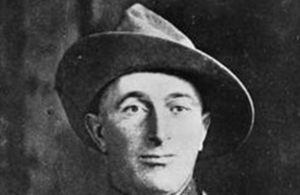WW1 New Zealand VC recipient Richard Charles Travis
The story of New Zealand First World War Victoria Cross recipient Richard Charles Travis.

Richard Charles Travis [Credit: © IWM (detail of Q 80571)]
16 men from New Zealand received the Victoria Cross, Britain’s highest award for gallantry, during the First World War. As part of the Centenary Commemorations the people of the United Kingdom marked their gratitude to those courageous men by presenting a bronze memorial plaque to their home country engraved with their names. The plaque is now displayed in the grounds of the New Zealand Parliament, Wellington. This archive tells their stories.
Name: Richard Travis
DOB: 6 April 1884
Place of Birth: Opotiki, New Zealand
Date of Action: 24 July 1918
Place of Action: Rossignol Wood, France
Rank: Sergeant
Regiment: 2nd Battalion, Otago Infantry Regiment, New Zealand Expeditionary Force
Richard Travis was born Dickson Savage in 1884 in Opotiki, New Zealand, but he changed his name to Travis to make a clean break after claims of impropriety. He worked as a farm hand and horse breaker before enlisting in the New Zealand Expeditionary Force, less than a month after the outbreak of the First World War.
Travis served briefly in Gallipoli before being sent to the Western Front where he earned a reputation as a scout. He was awarded the Distinguished Conduct Medal in September 1916 for his actions in the Somme, and in 1918 he earned the Belgian Croix de Guerre and later the Military Medal. He was awarded the Victoria Cross posthumously for his actions on 24 July 1918 at Rossignol Wood in France. His citation reads:
For most conspicuous bravery and devotion to duty. During ‘surprise’ operations it was necessary to destroy an impassable wire block. Sjt. Travis, regardless of personal danger, volunteered for this duty. Before zero hour, in broad daylight and in close proximity to enemy posts he crawled out and successfully destroyed the block with bombs, thus enabling the attacking parties to pass through. A few minutes later a bombing party on the right of the attack was held up by two enemy machine guns, and the success of the whole operation was in danger. Perceiving this Sjt. Travis with great gallantry and utter disregard of danger, rushed the position, killed the crews and captured the guns. An enemy officer and three men immediately rushed at him from a bend in the trench and attempted to retake the guns. These four he killed single handed, thus allowing the bombing party on which much depended to advance. The success of the operation was almost entirely due to the heroic work of this gallant N.C.O. and the vigour with which he made and used opportunities for inflicting casualties on the enemy. He was killed 24 hours later when, in a most intense bombardment prior to an enemy counter-attack, he was going from post to post encouraging the men.
Sergeant Travis was killed by shellfire the following day. He was buried at Couin in France.